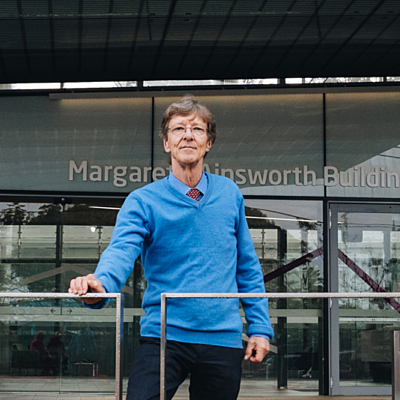Dr Claire Boswell-Ruys
Senior Research Fellow

Current Appointments
Foundation Scientist, NeuRAKey Research Areas
Simon Gandevia (MD PhD DSc FAA FRACP FAHMS FTPS) trained at the University of New South Wales and the Prince Henry Hospital. He has broad research interests in human movement control and he has used a wide range of techniques to examine fundamental aspects of pathophysiology in human neuroscience and clinical medicine. Major areas of work include proprioception, motor control and respiratory muscle control.
He established the Spinal Cord Injury Research Centre at NeuRA in 2020. It now undertakes major clinical trials in spinal cord injury, including eWALK. The research often sits at the interface between clinical medicine and human neurophysiology. He has a major interest in motor impairments and led an NHMRC program into it.
Professor Gandevia is one of the four Founding Scientists of the Prince of Wales Medical Research Institute (in 1992), which was later renamed NeuRA. He was also a founder of the 3T Clinical Research Imaging Centre and is an honorary clinical neurophysiologist at the Prince of Wales Hospital. He has served on many editorial boards, including the Journal of Physiology and was one of the longest serving Associate Editors for the Journal of Applied Physiology (2005-2023). He remains the only scientist to have published more than 100 papers in the Journal of Physiology. His clinical work includes patients with neuromuscular disorders and those with spinal cord injury.
He leads a group at NeuRA concerned with research quality. You can read more about the Research Quality Committee and their work here.
2025, 15 Oct
Temporal summation in human peripheral axons when stimulated transcutaneously with a 10‐kHz waveform
View full journal-article on https://doi.org/10.1113/EP092659
2025 Oct
The perception of the position of an unseen limb: Investigation of the effect of thixotropic conditioning on drift and accuracy
View full journal-article on https://doi.org/10.1113/EP092686
2025, 30 Sep
Impact of respiratory muscle training on sleep disordered breathing in people with tetraplegia: A sub-analysis of a randomised controlled trial
View full preprint on https://doi.org/10.21203/rs.3.rs-7522267/v1
2025, 29 Sep
Maximal strength and voluntary activation of adductor pollicis after a single session of acute intermittent hypercapnia or acute intermittent hypoxia
View full journal-article on https://doi.org/10.1113/EP093227
2025 Aug
Myths and methodologies: Invasive and non‐invasive assessment of respiratory muscle activity in humans
View full journal-article on https://doi.org/10.1113/EP091526
2025, 01 Jul
The relation between proprioceptive ability and physical function in people with stroke, Parkinson’s disease, and multiple sclerosis: a systematic review
View full journal-article on https://doi.org/10.1152/japplphysiol.00088.2025
2025, 01 Feb
Differential effects of stimulation waveform and intensity on the neural structures activated by lumbar transcutaneous spinal cord stimulation
View full journal-article on https://doi.org/10.1152/jn.00266.2024
2025, 01 Jan
Detection and perception of inspiratory resistive loads in older adults with and without chronic obstructive pulmonary disease
View full journal-article on https://doi.org/10.1152/japplphysiol.00398.2024
2025 Jan
The effect of abdominal functional electrical stimulation on blood pressure in people with high level spinal cord injury
View full journal-article on https://doi.org/10.1038/s41393-024-01046-w
2024 Nov
Pain tolerance and the thresholds of human sensory and motor axons to single and repetitive bursts of kilohertz‐frequency stimulation
View full journal-article on https://doi.org/10.1113/JP286976
Every dollar of community support enables our scientists to continue making life-changing discoveries that contribute to a brighter and healthier future.
Run, swim or bake your way to making a positive difference in the lives of people touched by brain and nervous system disorders.
Stay informed about our latest research breakthroughs, scientific discoveries and the incredible minds behind them – subscribe today.
Neuroscience Research Australia respectfully acknowledges the Bidjigal and Gadigal peoples of the Eora Nation as the Traditional Owners of the Land on which we stand and pay our respects to Elders past and present.
Redevelopment of the NeuRA website has been made possible by the generous support of Conexus Financial.